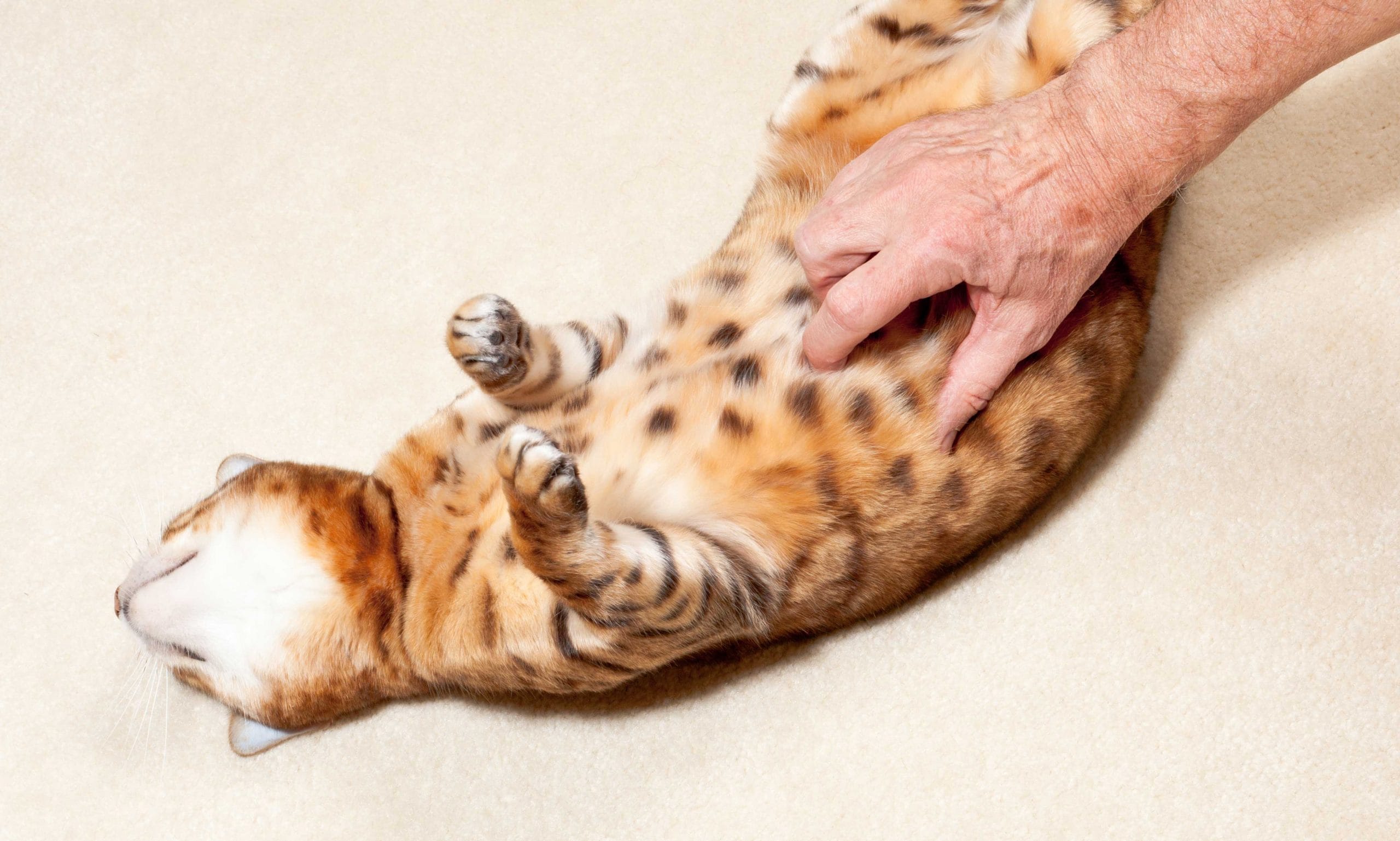You’re petting your cat, they’re purring, you’re experiencing those feel-good endorphins… And then you feel it: Your cat has a lump on the side of their stomach. Your first thought is likely, “What is this?” If you let your mind wander a bit, it might tread into territory. “Could it be a tumor? And could that tumor be cancerous?”
Before jumping to the worst-case scenario, take a breath after you discover that your cat has a lump on their abdomen. We spoke with two vet experts about the possibilities, the symptoms and causes, and what steps to take next.
Click to jump to each section:
What Is This Lump Under My Cat’s Skin?

- Abscess: an accumulation of tissue, usually containing pus
- Lipoma (and other benign tumors)
- Cyst: a fluid-filled lump
- Hernia: an internal hole in the body wall where fat or organs push through
- Neoplasia/malignant tumor: a cancerous growth of many varieties in cats
- Organ Enlargement: exactly what it sounds like—an organ becomes enlarged
However, call your vet and make an appointment to have your cat checked out. They will consider the different conditions that could possibly be causing the abdominal skin lump.
Cats can develop tumors on their mammary glands specifically, says Audrey Weaver, partner doctor at Heart + Paw in Glen Mills, Pennsylvania. These are also known as mammary tumors and are easily felt. (Note that cats can develop tumors on their organs, but tumors on abdominal organs are unlikely to be felt by pet parents.)
Fibrosarcomas and mast cell tumors “are not the more common abdominal tumors in cats, but both can affect the skin,” Dr. Weaver adds, categorizing them as malignant tumors.
How Will the Vet Diagnose the Lump On my Cat?

“A vet may be able to determine the cause of a lump by visual evaluation and listening to the history,” says Dr. Sarah Jacobs, DVM, emergency veterinarian at Veterinary Emergency Group in Clifton, New Jersey.
However, your vet might need to perform other tests to find an answer, including:
- Bloodwork and urinalysis: A complete blood count (CBC) and chemistry, as well as urinalysis “can give the veterinarian a snapshot of how the pet’s internal organs and immune system are functioning,” Dr. Weaver explains. “The CBC will give the veterinarian the red blood cell counts, white blood cell counts, as well as platelet numbers.”
- Fine needle aspiration: This test is done “to obtain a sample of cells from the lesion of concern to be evaluated under a microscope,” Dr. Weaver says, adding that it’s often one of the first diagnostic tests your vet will perform on a worrisome lump.
- Biopsy: Your vet may perform a biopsy of the lump, as the sample size of the tissue is often larger. The purpose is the same as with a fine needle aspiration.
- Ultrasound: If the vet finds your cat has a tumor, they may do an ultrasound as part of the staging process, as well as “to evaluate the abdominal organs to ensure there is no evidence of metastasis or spread of the cancerous cells,” Dr. Weaver says.
- X-ray: Like the ultrasound, an X-ray will help the vet during the staging process. “Often X-rays of the chest are performed to rule out evidence of metastasis to the lungs when a malignant tumor is diagnosed,” Dr. Weaver says. “The lungs are a common location of metastasis for many malignant tumors.”
- Histopathology: If the vet removes the lesion, Dr. Weaver says they may order a histopathology report. During this test, “a large sample size of abnormal tissue or the entire mass is evaluated in layers under microscopy.”
- CT scan: This form of advanced imaging can be helpful to the vet to both rule out metastasis and to “aid the surgeon in determining the precise location of the lesion for safe surgical removal,” says Dr. Weaver.
If you’ve noticed symptoms that are out of the ordinary—maybe your cat has been acting unwell or they’ve experienced weight loss—or you have an idea of how quickly the lump has grown (or if it appears to have been slow-growing), share with your vet. This information could help them determine the cause of the skin lump.
What Are the Treatment Options for a Cat’s Abdominal Lump?

Abscess
The treatment for an abscess “typically includes lancing the abscess to drain the purulent material/pus, flushing the wound, a course of antibiotics [and] pain medications,” Dr. Weaver says.
Be prepared for your cat to come home wearing an Elizabethan collar (a recovery e-collar) if the abscess is in a location the cat can lick. Licking could cause further infection.
Lipoma or Other Benign Tumor
If it turns out the cause of the lump on your cat’s body is a lipoma, there’s good news! You probably don’t have to do anything.
“Lipomas and other benign growths don’t usually require treatment, unless they get so large that they interfere with the cat’s movement,” Dr. Jacobs says.
Cysts
Vets often lance and drain the fluid in cysts.
“This fluid can re-accumulate at an unknown rate,” Dr. Weaver says. “Surgery to remove the cyst lining may be needed to prevent fluid from returning.”
Hernia
Dr. Jacobs says a hernia will require surgical repair. Your vet will help you understand the type of hernia your cat has, as well as surgical options if it turns out a hernia is the cause of the lump.
Neoplasia/Malignant Tumors
Treatment depends on the type of tumor the cat has and whether it has spread, Dr. Jacobs says. It may be possible to remove the tumor, and/or there may be chemotherapy and radiation options. A referral to a specialist will most likely be in order if a tumor is causing the lump.
Organ Enlargement
Your vet will start with bloodwork to rule out evidence of organ dysfunction, Dr. Weaver says. Additionally, they can use advanced imaging—like CT and abdominal ultrasound—so they have a 3D view of your cat’s organs.
“Medications, supplements, diet changes, etc., may be indicated to help resolve the organ enlargement,” Dr. Weaver explains.
What Can I Do To Prevent an Abdominal Lump?

- Be in tune with your pet. When you're snuggling or petting your cat, “rub them all over, feel for lumps, bumps and areas of discomfort,” she advises. If you find anything, call your vet!
- Schedule regular check ups with the vet. She gives the following age guidelines to determine the frequency of vet visits:
- Senior cats (7 years and older): every six months to one year
- Young cats (under 7 years old): at least every one to two years
- Trust yourself, pet parents! Trust your gut, and take your cat to the vet if you have concerns.
As for what you can do to prevent the lump in the first place, you’re limited. You can cut down on the likelihood of abscesses by keeping your cat indoors.
Additionally, you can spay your cat.
“Not spaying a cat or dog can put them at higher risk for developing mammary tumors, which tend to be malignant and aggressive,” Dr. Weaver says.
Frequently Asked Questions
Q:
Are there related symptoms that could indicate the lump is something more serious?
Q:
I’m worried the lump could be a cancerous tumor. Is there any way to tell?
Q:
Could fleas or an allergic reaction be the reason my cat developed a skin lump?
More on caring for your cat:
Share:









